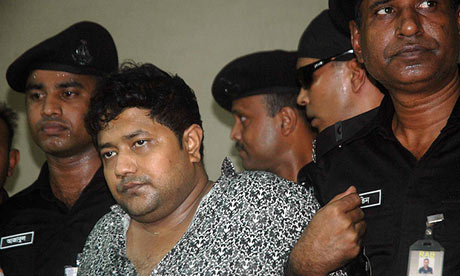When the building he owned collapsed, entombing hundreds of garment workers beneath its choking rubble, Mohammed Sohel Rana vanished. He abandoned his home in Savar, 12 miles north of the Bangladeshi capital, Dhaka, and drove off. While rescuers frantically dug out the living and the dead, Rana was nowhere to be seen.
On Sunday, however, Bangladeshi police caught up with the fugitive politician, arresting him in the border town of Benapole, 250 miles away. He had been trying to escape into neighbouring India. Instead, a group of commandos flew Rana back to Dhaka by helicopter.
“Acting on a tipoff, we apprehended Sohel Rana, the man who is responsible for the [Dhaka suburb of] Savar tragedy,” Colonel Mokhlesur Rahman said. Flanked by two policemen, Rana was wearing an ash-blue shirt with white spots. He looked dishevelled and fidgety.
Many say the owner should now be executed for his role in the tragedy, in which nearly 400 people are so far known to have died. “He should be hanged for causing the deaths of so many people,” Masuma Akter, whose brother is still missing, told the Guardian.
Rana’s arrest sparked celebrations at the site of the eight-storey complex, Rana Plaza, where relatives are still desperately waiting for news of missing loved ones. On Sunday evening, police charged Rana with criminal negligence and illegal construction.
Smoke, meanwhile, billowed from the wrecked site, sending rescue teams scurrying for safety. A fire service official at the scene said a fire started after army engineers tried to cut through a column to gain access to an air pocket where four people were believed to be trapped.
The fire illustrated the difficulties rescuers face in getting people out of the tangled mass of steel and concrete. Shams Uddin, a firefighter, said his team had been trying since morning to rescue a woman named Shahana, but their efforts failed when the fire broke out.
“We were talking to her, giving her oxygen, while we cut through the concrete,” he said. “But after hanging on for four days, she died in the fire. Three of my men were also injured and are now in hospital.”
Rana’s dramatic capture raises a broader question: whether Wednesday’s disaster was all the fault of one man, or, as some suggest, was the product of Bangladesh’s dysfunctional system, where politics and business are closely connected, corruption is rife, and the gap between rich and poor continues to grow.
Rana, the son of a poor door-to-door salesman, entered local politics and became a member of the ruling Awami League’s youth front. He has also worked for its bitter rival, the Bangladesh National party (BNP).
“Whatever party is in power, he is there,” Ashrafuddin Khan Imu, another Awami League leader, told news agencies. Most recently, Imu said, Rana had been working for a local member of parliament, Talukder Touhid Jang Murad.
Rana’s influential political contacts allowed him to circumvent the rules and to get rich. He reportedly bought several government-owned properties at a discount and in 2010 constructed Rana Plaza on the site of a pond. The building was supposed to be five storeys high; Rana added an extra three. Two local engineers and the mayor – a political ally – signed off on the project.
On Wednesday, Rana confidently insisted the building was safe, despite the discovery of ominous cracks. He told 3,200 workers employed by five garment companies that they had nothing to worry about and should return to their jobs. “The building has minor damage. There is nothing serious,” he insisted. “It will stand for a hundred years.” At 8am, the shift began. Forty-five minutes later, the building collapsed.
Bangladesh’s garment industry accounts for 80% of the country’s total exports, and last year generated $20bn (£13bn). But it is also frequently caught up in the country’s venomous political struggles and strikes are frequent. These, in turn, place pressure on managers to deliver orders for western companies. The owners of garment factories are reluctant to send their workforces home.
There was some good news earlier in the day, as five survivors were pulled alive from the rubble more than 100 hours after the collapse, bringing to more than 2,400 the number of people rescued. But rescuers say hope is fading for the hundreds who are still missing after the accident.
The death toll continued to rise on Sunday evening, as army and fire service teams prepared to move in with heavy equipment to clear large chunks of fallen masonry.
Families of those missing have been pleading with the authorities not to use heavy machinery, fearing that survivors could be crushed underneath.
On Saturday, police also arrested the owner of Phantom Apparels Ltd, a clothing company that was housed on the fifth floor of the Rana Plaza. The company lists the Spanish fashion label Mango and other international retailers among its clients.
The arrest brings to three the number of clothing company owners arrested over the deaths. A spokesman for the garment manufacturers’ association said all three had given themselves up to police voluntarily.
Bangladesh’s prime minister, Sheikh Hasina, keen to distance her party from the disaster, had demanded Rana’s arrest. Her home minister had initially suggested that the building might have come down after opposition supporters shook the walls. The statement was swiftly withdrawn.
The outlook for Rana now does not look favourable. His political allies have abandoned him, Bangladesh’s most powerful garment industry association says he ignored its warnings to shut the building, and the prime minister herself called for his arrest.



Leave a reply